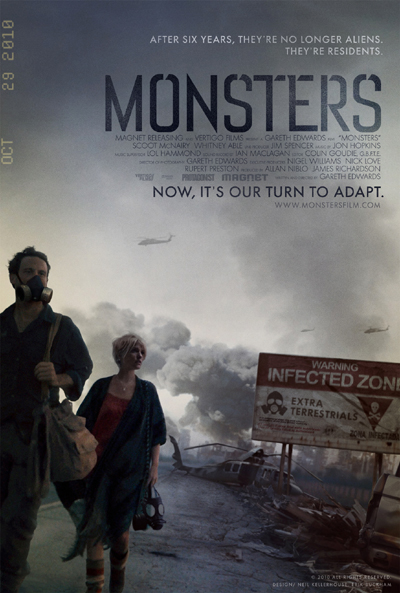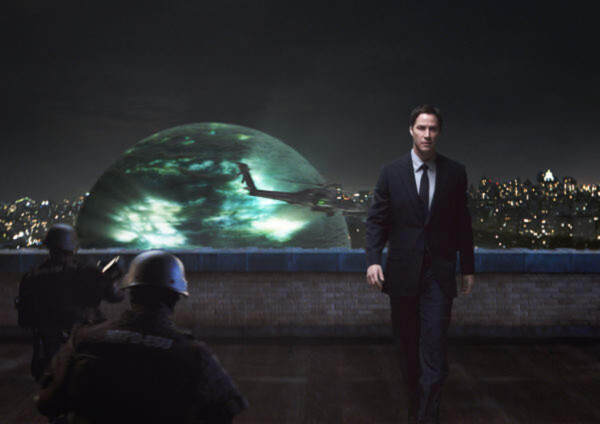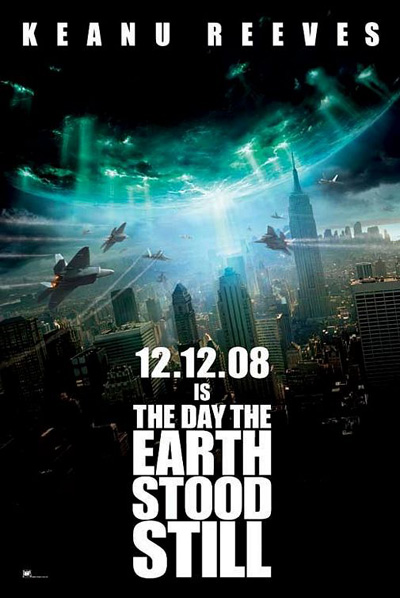Del and Mladen review ‘Monsters’

Monsters-movie-image
Image courtesy of Magnet.
—
“Monsters” Starring Scoot McNairy and Whitney Able. Directed by Gareth Edwards. 94 minutes. Rated R.
Del’s take
Late in the movie “Monsters” there comes a moment a literary book reviewer might call “luminous.” Ever notice how literary book reviewers always bring the word “luminous” into play, as if to excuse the lack of plot, the unfolding of dreary characterization and the trendy massacre of clearly wrought prose? You will never hear a Larry Bond novel called “luminous.”
This illuminating moment takes place when our two protagonists, Andrew (Scoot McNairy) and Samantha (Whitney Able), witness two 300-foot tall walking squids engage in making out, foreplay, maybe actual intercourse – with all the flailing tentacles, bioluminescent pulsing and noble whale song-like groaning it’s hard to tell what’s going on. Andrew and Samantha watch in awe as these two leviathans perform the vertical bop and you expect them to whisper, “Beautiful” as they gaze adoringly at each other.
I was whispering “Will somebody please BLOW THESE THINGS UP?”
To paraphrase my friend Kari: “Monsters” is what happens when an indie filmmaker, the cinema equivalent of a literary writer, tells himself, “We have nothing to fear but fear itself … and monsters.”
“Monsters” isn’t about monsters, that’s for sure. The monsters are metaphors for Andrew and Samantha, or illegal immigration, or existential angst. But it is more about the message getting lost in a stew of competing thematic imperatives.
The story goes like this: NASA discovers evidence of life elsewhere in our solar system and dispatches a probe to recover a sample. The probe crashes somewhere in Mexico and shortly thereafter weird creatures begin disrupting the flow of cocaine to America. Andrew, a jaded photojournalist, goes into the “infected zone” to document the mayhem. But he somehow becomes responsible for escorting his publisher’s daughter, who has been in the area, back to the States. They try by land, sea and air but due to a series of setbacks, mostly caused by their own stupidity, they fail and must travel directly through the infected zone to reach the gigantic wall America has constructed along its border with Mexico. Along the way Andrew, who has a kid but not a wife, and Samantha, who is to marry a fellow she doesn’t love, discover a growing affinity for each other. Can you guess how this is going to end?
I will give Edwards credit: “Monsters” is ambitious. It is not another “Godzilla,” “The Mist” or “Cloverfield.” What I didn’t like about it, however, was the plodding pace, the incompetence of the characters and their forced transformations, which did not encourage me to suspend my disbelief.
Characterization is shaky. We are expected to dislike Andrew at first because of his cynicism, then bond to him as he realizes there’s more to life than shooting a prize-winning photo. In reality Andrew is a scummy opportunist who shacks up with prostitutes when Samantha won’t sleep with him, something he pursues with such diligence that Samantha could have had him arrested for sexual harassment. And Samantha, as the poor little rich girl, is a cipher with no real purpose for existence other than serving as an object of desire for Andrew.
At every critical juncture in their journey they pause, undecided, then embark on some irrelevant and unrealistic conflict that jeopardizes their success. For instance, at one point they must get off a boat and travel overland under the watchful eye of armed guards – except Andrew doesn’t want to because the guards are carrying guns. Um, excuse me, but what part of “armed” did he not understand? And in a land occupied by 300 foot-tall squids who like to squash human beings, would you rather your guards be armed with Nerf Frisbees?
And once they reach the wall, well. It’s every Tea Partier’s dream, a cement monolith designed to keep out “illegal aliens.” Except the aliens, as we see in the scene I referenced above, are nothing more than noble, benighted creatures who want nothing more out of life than a brief interlude of happiness amidst an uncaring world. Except they are 300 feet tall and like to squash humans. I say, “Will somebody please BLOW THESE THINGS UP?”
“Monsters” is an interesting movie but it has problems. On a scale of A to F I would rate it a C+.

Mladen’s take
Let’s start with a list.
They’re 300-foot-tall walking octopi, or is it octopuses? Get your mollusks straight, Del.
They do get blown up, you savage, it’s just not witnessed, and,
“Monsters” the movie has one of loveliest, mournfully serene soundtracks ever pasted to celluloid.
For me, the best way to characterize “Monsters” is this: The movie is deeply satisfying, but superficially disappointing.
It took me about 20 minutes to realize that the film was unlike a Godzilla smashfest, “Cloverfield,” or “The Mist.”
After that, I shed the expectation of carnage and allowed the movie to chart its own course. The story is about man’s inhumanity to man and our reckless belief that we can corral nature.
Samantha and Andrew are likable tools used to teach us a lesson. They do a good job leading us through the Infected Zone, where the alien creatures have established a sanctuary after being brought to Earth by a NASA probe that crashed.
Once in the zone, the duo exists to draw attention to the look of civilization as it’s consumed by its own folly.
Vines overtake hotels built for tourists.
An F-15 emerges from the depths of a river, playfully pulled through the black water by one of the tentacled beasts. It never bothers Samantha, Andrew, or the crew of the longboat hired at an exploitative price to help get the Americans back to America.
When the couple finally reaches the U.S.-Mexico border, it discovers that the zigzagging walled fortress separating one country from the other has been abandoned. The aliens had breached its ramparts. The fight has come to the Homeland.
Agreed, there’s some hokey symbolism in “Monsters.” Del already gave examples, but you have to give the director of the film credit for trying to create something original.
“Monsters” is an artsy film with a liberal message, which ain’t gonna play too good in these parts.
Sit back and enjoy the film, paying attention to events and scenes framing the relationship between Samantha and Andrew because that’s the movie’s strength.
Mladen Rudman is a former journalist and technical editor. Del Stone Jr. is a former journalist and author.

Klaatus (Keanu Reeves) arrival on Earth via a giant sphere, triggers a global upheaval.
Image courtesy of 20th Century Fox.
—
“The Day the Earth Stood Still,” starring Keanu Reeves, Jennifer Connelly, Kathy Bates, Jaden Smith, and John Cleese. Directed by Scott Derrickson, 103 minutes, rated PG-13.
Mladen’s take
Add the recently released re-make of “The Day the Earth Stood Still” to the ever-growing list of hokey films about redemption.
In fact, if you’re tired of watching Rudolph the red-nosed reindeer and his dwarf friend discover that they’re wonderful beings no matter what anyone else believes, consider “The Day the Earth Stood Still” as alternative holiday viewing fare. Here, the whole of humanity is redeemed.
There are no subtleties in this sci-fi movie.
Klaatu, the alien portrayed by Keanu Reeves, arrives aboard a cloudy, sparkling sphere. He’s an interstellar diplomat without portfolio sent by a god-like cabal of deep-space civilizations.
Klaatu’s mission is to evaluate Earth’s health. The prognosis ain’t good.
It isn’t too long before he tells astrobiologist and unwitting ally Helen Benson, played by Jennifer Connelly, that extra-galactic help would be needed to save the planet.
Benson assumes that means helping humanity but eventually figures out she’s mistaken. Klaatu had concluded that the only way to save Earth is by eradicating mankind.
The universal diplomat, protected by GORT, a very impressive gigantic automaton comprised of nano-sized wasps behaving as a single being, initiates Operation Roach Motel after explaining to Benson that, in essence, humanity is a cosmic error.
Meanwhile, what does the U.S. Defense Department do when it encounters hyper-intelligent, unbelievably technologically sophisticated entities from distant worlds? It tries to kill them, of course.
Throughout the movie, Klaatu or GORT turn military target acquisition devices, laser illuminators and high-performance aircraft against the troops using them. The aliens – masters of the electro-magnetic spectrum, severe traumatic injury repair, pure reason, and unemotive faces – gain control of the weapons systems by wireless hacking.
It takes Benson’s unceasing effort to protect her belligerent young stepson and a brief exchange of mathematical equations and a little conversation with a Nobel Prize-winning scientist for Klaatu to start recognizing that humanity ain’t all bad.
It seems – and this has never, ever, been expressed in other movies, books, poems, pamphlets, hieroglyphics or pre-Sumarian script – that humanity can become its best only after demonstrating its worst. The Nobel laureate argues that mankind has some kind of intrinsic sense that will let it know when there has been enough bloodletting and destruction of the environment, as well as the moral fortitude to correct those mistakes when the time comes.
Klaatu starts seeing the microscopic good among the overwhelming evil around him and reverses his decision to obliterate all traces of humanity. The mechanism for scraping clean the Earth’s surface is the neatest visual part of the movie. GORT dissolves into a swarm of flying nano-bots that consumes everything in its path, organic or inorganic.
The swarm is one of a few transparently biblical references in “The Day the Earth Stood Still.” Hell, at one point Klaatu even walks on water. Hallelujah.
“The Day the Earth Stood Still” is an OK movie, probably worth the price of a matinee ticket. But, I’m worried about Reeves. Come on, man, next time give me something as spectacular and revolutionary as “The Matrix.”

Del’s take
It isn’t the Earth that’s standing still – it’s Hollywood.
Talk about a movie that didn’t need remaking. “The Day the Earth Stood Still” circa 1951 is a Robert Wise classic that to this day presents a quietly dignified message about the follies of war.
“The Day the Earth Stood Still” circa 2008 is a diabetic coma-inducing fried Snickers bar of a mess, covered with sugar-dot cliches and gluey nuggets of contrived melodrama – all of it wrapped in a cloying caramel blanket of unconvincing CGI.
I’m still trying to figure out which cliché most nauseates me – the save-the-environment cliché, the racial-harmony cliché, the empowered woman cliché, the all-government-employees-are-evil cliché, the stupid-military cliché … see what I mean? One more cliche and you’d have a C-bomb big enough to do the aliens’ work for them.
Most of the characters in “The Day the Earth Stood Still” are cardboard cut-outs with Keanu Reeves winning the Oscar for Best Performance by a Stoned-Out Quualude Refugee. The lone exception is Will Smith’s kid, Jaden, who plays the rebellious and disrespectful stepson of Jennifer Connelly’s Helen Benson character (has there ever been a stepchild who liked his new mom or dad?).
Let’s not talk about logic flaws … well heck, let’s do.
Here’s the deal: The aliens have come to Earth because there are few habitable planets in the galaxy and humanity is ruining this one. To fix everything the aliens plan to unleash a biblical horde of tiny robots that will dismantle mankind molecule by molecule, restoring the earth to pristine form … presumably to serve as home base for a future alien megalopolis.
Stop and think about it – if E.T. has that kind of technology, why not unleash it on an uninhabitable world, making it habitable? Science calls the process “terraforming,” a piece of cake for Klaatu and pals.
But then there’d be no movie – albeit a stupid movie, and be $8 to the richer. And I could use that $8 to make the world a better place so we’d never again be afflicted with Keanu Reeves.
Or I could just buy beer to wash away the taste of this nasty movie.
Mladen Rudman is a former journalist and technical writer. Del Stone Jr. is a journalist and author.